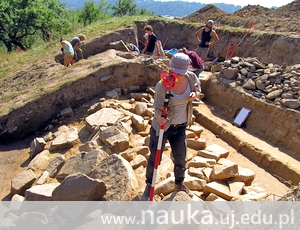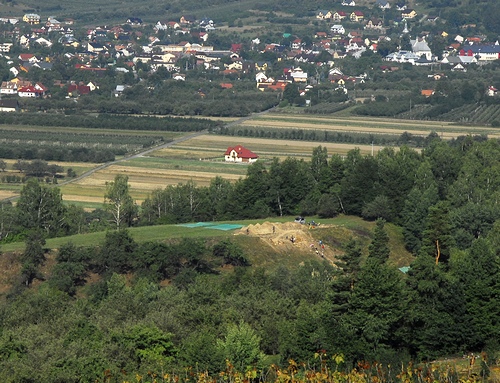
Remains of stone architecture form the Bronze Age have been discovered in the Polish Carpathians.
Góra Zyndrama (Zyndram's Mountain) in Maszkowice (south Poland) has been a well-known archaeological site since early 20th century. In 2010, a JU research exhibition began excavations in a hitherto unexplored place on the eastern hillside, at the ridge of the mountain's flat top. Their study has shown that under the remains of a hamlet discovered in previous excavations, there are traces of a much older settlement, dating back as far as the Bronze Age.
Protected by stone fortifications
 The settlement at Maszkowice was built build on a spectacular scale compared to others in its time. Its inhabitants flattened the top of the mountain, creating a field measuring about half a hectare (a little more than one acre). They used the remaining clay to build a terrace on the eastern and northern slope of the mountain, which was then reinforced by a dry wall, built out of large sandstone blocks plastered with clay. There are very few settlements in Central Europe which possessed stone fortifications at that time, since using stone as building material is more characteristic of Mediterranean civilisations. In Central Europe's more temperate climate, fortifications were usually built out of wood and clay. After further excavations, the archaeologists have discovered another layer of the wall, made of even larger sandstone blocks, some of which have been shaped into regular hexagons.
The settlement at Maszkowice was built build on a spectacular scale compared to others in its time. Its inhabitants flattened the top of the mountain, creating a field measuring about half a hectare (a little more than one acre). They used the remaining clay to build a terrace on the eastern and northern slope of the mountain, which was then reinforced by a dry wall, built out of large sandstone blocks plastered with clay. There are very few settlements in Central Europe which possessed stone fortifications at that time, since using stone as building material is more characteristic of Mediterranean civilisations. In Central Europe's more temperate climate, fortifications were usually built out of wood and clay. After further excavations, the archaeologists have discovered another layer of the wall, made of even larger sandstone blocks, some of which have been shaped into regular hexagons.
Mediterranean model
 The stone fortifications at Zyndram's Mountain are the oldest stone walls in Poland, more than 2,500 years older than any remains of Romanesque architecture. Due to their size and the materials used in their construction, they are more similar to the buildings erected by the Mediterranean civilisations during the Bronze Age. In 2011, the archaeologists have discovered a violin idol in a layer dated on approximately 1500 BCE. The violin idols were very popular in Mycenaean Greece and northern Balkans. They were probably representations of a female deity.
The stone fortifications at Zyndram's Mountain are the oldest stone walls in Poland, more than 2,500 years older than any remains of Romanesque architecture. Due to their size and the materials used in their construction, they are more similar to the buildings erected by the Mediterranean civilisations during the Bronze Age. In 2011, the archaeologists have discovered a violin idol in a layer dated on approximately 1500 BCE. The violin idols were very popular in Mycenaean Greece and northern Balkans. They were probably representations of a female deity.
The discovery is important not only as a piece of historical information, but also a powerful science communication tool, as they allow for simple yet detailed observation of an ancient archaeological site.
Photographs by M. Przybyła and A. Maślak.





